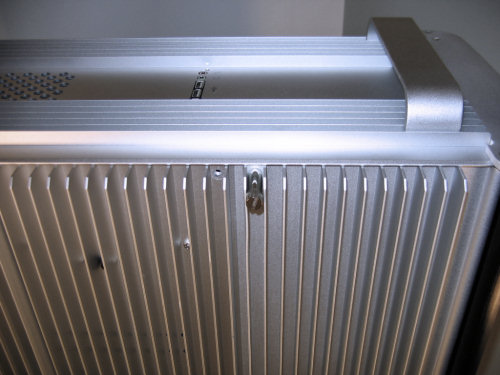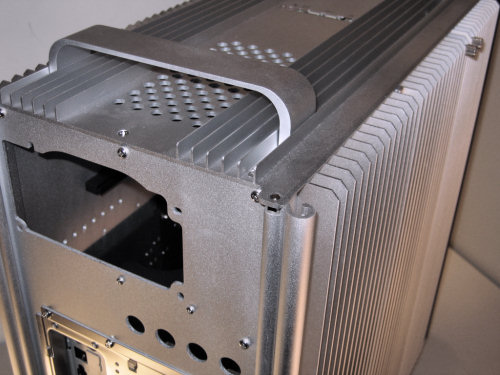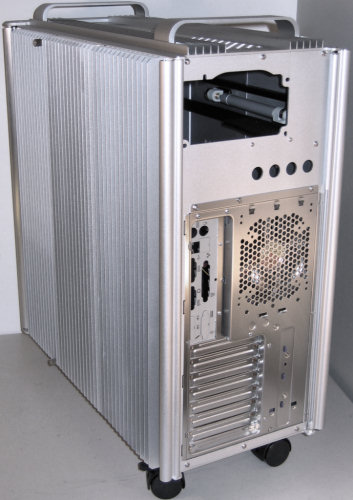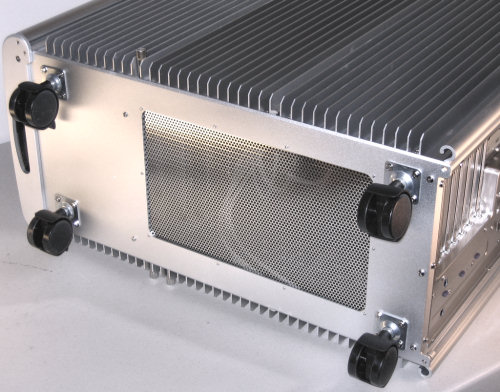Clash of the Titans - TT Tai Chi vs. CM Stacker 830
by Joshua Buss on February 23, 2006 12:05 AM EST- Posted in
- Cases/Cooling/PSUs
Thermaltake Tai Chi (cont’d)
An inch and a half long extended thumbscrews hold each part of the hinged door at the top and bottom, and since it's a double-hinge design on the left side, a total of four thumbscrews can be used – however, the front flap overlaps the main door and thus a single screw on the front panel at the top or bottom is the minimum needed to hold the side shut.
Moving further backwards, we can take a close look at the rear handle and rear backing plate. The thickness of the aluminum panels is very evident in this picture, as is the fact that the case can be completely separated into component parts and screws.
At first, this feature might seem rather unimportant, but the more that one thinks about it, the more obvious it is that to the enthusiast and even casual modder, this component nature is exceptionally valuable. For instance, the default ports visible in the back plate here for water cooling are 3/8” in diameter, which is fine for 3/8” O/D water tubing. However, 3/8” ID (inner diameter) tubing is pretty popular too, and without the ability to remove this plate from the rest of the case precisely enlarging these holes to the proper size would be much more difficult.
The over-sized rounded edges on the back resemble the look of the corners at the front of the case, but more importantly, they simply provide protection from the rest of the back of the computer and the rear-most fins of the side panels. Notice also how the rear of the case and the back of the motherboard area are completely separate, so that with a different motherboard standard such as BTX, all one needs to do is replace this back plate.
Turning the case on its side to inspect the bottom reveals that just as much attention to detail has been paid to it as the rest of the case. First off, notice that the heavy-duty casters are removable, should one decide they really would have the case take up less vertical space or simply have replacements that they'd rather use instead. When raised, however, the case benefits from the additional airflow capabilities of the hole in the front area and large perforated steel section. With the default casters left in place, a standard 120mm case fan can actually mount directly to this mesh from the bottom and still have enough clearance underneath it to function well.
Before opening the case, we really felt that this case deserved an extreme close-up to show off the immaculate finish and heavy thickness of the aluminum used.
The Tai Chi is really almost an entirely new kind of case, and the construction and sheer quality of materials used are some of the easiest ways to really see what we mean by this. In this photo, notice for instance how nice the contrast between the brushed finish of the front doors and the brilliant finish of the rest of the case look. Aesthetically, there simply isn't any other case to which to compare the Tai Chi – its marriage of passive radiation with other functionality-driven design choices gives it a unique, stately, and downright intimidating style that really requires seeing it in person to appreciate.
An inch and a half long extended thumbscrews hold each part of the hinged door at the top and bottom, and since it's a double-hinge design on the left side, a total of four thumbscrews can be used – however, the front flap overlaps the main door and thus a single screw on the front panel at the top or bottom is the minimum needed to hold the side shut.
Moving further backwards, we can take a close look at the rear handle and rear backing plate. The thickness of the aluminum panels is very evident in this picture, as is the fact that the case can be completely separated into component parts and screws.
At first, this feature might seem rather unimportant, but the more that one thinks about it, the more obvious it is that to the enthusiast and even casual modder, this component nature is exceptionally valuable. For instance, the default ports visible in the back plate here for water cooling are 3/8” in diameter, which is fine for 3/8” O/D water tubing. However, 3/8” ID (inner diameter) tubing is pretty popular too, and without the ability to remove this plate from the rest of the case precisely enlarging these holes to the proper size would be much more difficult.
The over-sized rounded edges on the back resemble the look of the corners at the front of the case, but more importantly, they simply provide protection from the rest of the back of the computer and the rear-most fins of the side panels. Notice also how the rear of the case and the back of the motherboard area are completely separate, so that with a different motherboard standard such as BTX, all one needs to do is replace this back plate.
Turning the case on its side to inspect the bottom reveals that just as much attention to detail has been paid to it as the rest of the case. First off, notice that the heavy-duty casters are removable, should one decide they really would have the case take up less vertical space or simply have replacements that they'd rather use instead. When raised, however, the case benefits from the additional airflow capabilities of the hole in the front area and large perforated steel section. With the default casters left in place, a standard 120mm case fan can actually mount directly to this mesh from the bottom and still have enough clearance underneath it to function well.
Before opening the case, we really felt that this case deserved an extreme close-up to show off the immaculate finish and heavy thickness of the aluminum used.
The Tai Chi is really almost an entirely new kind of case, and the construction and sheer quality of materials used are some of the easiest ways to really see what we mean by this. In this photo, notice for instance how nice the contrast between the brushed finish of the front doors and the brilliant finish of the rest of the case look. Aesthetically, there simply isn't any other case to which to compare the Tai Chi – its marriage of passive radiation with other functionality-driven design choices gives it a unique, stately, and downright intimidating style that really requires seeing it in person to appreciate.















55 Comments
View All Comments
tscholz - Sunday, April 30, 2006 - link
As for cooling, these cases are some of the most stupid designs i have ever seen. What are all those meshes doing on the stacker, but ruining the cooling performance. The proper way to cool a case is by using vacuum, and not by sucking or blow huge amounts of air in and out from all directions. A case should have one air intake (might be a few smaller ones), and one output. Only one fan is needed on the output, since it creates the vacuum to suck new air in from the input intake(s).And as for the Tai Chi, no those fancy fans on the sides does not do much (if anything) for the cooling. The energy transfer rate from the air inside to the alu casing is very little, and does not match the effects of fresh air constantly moving through tha case. The only thing these fans will do, is to collect dust.
There is no doubt that the interior of these cases are cool then full of fans, but why use that many when you don't have to?! More fans equal more noise, and does not make it that much cooler.
For reference, my case has a total of 2 fans (3 if you count graphics), one in the PSU, and one in the back that cool CPU and keeps air flowing through the casing. I blocked off all those extra holes in the back and front, to make sure that the air flows past the HD's, over the chipset, through my Thermaltake Tower 112 (damn it's big), and finally blown out the back. At a room temp. at 23 °C, the interior and CPU temp is 32 °C idle (53 °C load).
seanp789 - Saturday, March 18, 2006 - link
alot fo people are wondering if these things really work and there are debates on both sides.I bought the case recently and have come to this conclussion.
A typical heatsink is in direct contact with the heat source. The tai chi case only comes in contact with air for the most part. Now there is no doubt that there is hot air inside your case. The longer your case is running at full load the more of an effect that hot air has on surrounding components. While its true that air is less conductive that a directly contact, the massive surface area the case provides as a heatsink is what allows it to be so effective.
For doubters, take this simple test I did. Use a blow dryer to heat the side of your case, then use a blow dryer on the tai chi case. you will find that the tai chi cools itself much faster than a normal case. While i didnt take exact temps I timed the dryer exposure time and relatively how long each case took to cool.
chynn - Thursday, March 2, 2006 - link
After you can mount an ATX motherboard in the motherboard tray, you can use either the left (normal) or right (inverted) case slots to insert the tray.You can relocate the four fan array to either side of the case.
You can change the side the front door is mounted to, which is great for left-handed people like me.
You have to screw down all components mounted in the 5.25in bays with the provided screws. The snap locks are there only for positioning and/or testing purposes.
The stock fans are noisy, sleeve bearing, and low MTBF units. Not good for this costly a case. OTOH, the fans in the ThermalTake might be just as bad ... :)
JoshuaBuss - Monday, May 15, 2006 - link
Actually the front door can't be turned upside down so that it opens the other way. I tried.. it doesn't fit.The snap locks work fine for permanent mounting...?
The stock fans I received are VERY quiet, even at 12v.
fsardis - Thursday, March 2, 2006 - link
do you even own the case? have you even heard the fans? FYI they are both inaudible and i speak from first hand experience cause i own the thing.just because it has a sleeve bearing doesnt mean its noisy.
Systemshocked - Wednesday, March 1, 2006 - link
I purchased an Armor case last year, and my one gripe about the case is the tool-less expansion card clamp (that green and purple thing in Anandtech's photos). It's flimsy, and it didn't fit with my Geforce 6800 GT video cards. So I removed it.So much worthless processed hydrocarbon in my opinion.
And I wouldn't trust it to hold my cards in place if you're planning on transporting the case anywhere.
My two cents.
seanp789 - Monday, February 27, 2006 - link
the specs measure the tai chi at 600mm or a little less than 2 feet. I woudl like to if height is measured with or without wheels and handles. because the clearance below my desk is right on the borderline and im afraid the handles will make it not fit.r33tr33t - Sunday, February 26, 2006 - link
Why doesn't AnandTech review the Zalman Totally No Noise Series?The TNN 500AF is more expensive than either of these cases and probably has competitive build quality.
Aikouka - Sunday, February 26, 2006 - link
I was wondering if you'd use some possible higher enthusiast (or just tests for plain looney people). What I mean by this is for example, I am in the market for a new case right now, because I currently have 5 HDDs in my Xaser III V2000A. I built a computer for a friend with a 7800GT SLi configuration and both of his video cards run 20C cooler than my single 6800GT (both being BFG OC cards). His 4800+ runs cooler than my 4400+ and I use a Thermalright XP90C with Arctic Silver V where he used the stuff that came in the box. So, yeah... thermals are why my games sometimes will mess up, but I'm not sure what cases are a good choice.Like I said, it's kind of leaning toward enthusiast/looney to do tests where you up the thermal anty, but there are people with multiple hard drives in their machines and for people in predicaments like mine (where their hard drives sit in front of their only intake fans), they're in quite the pickle.
chynn - Thursday, March 2, 2006 - link
So what case are you using, friend??? It would help if we knew ... :)For example, one of the reasons I am moving to the RC-830 is that my Lian-Li V1200 case does not cool the SLI graphics cards properly, so the whole case runs hot.
I have purchased the V1200 "Plus" cooling kit and some 120mm Scythe SFF21F fans though to remedy that problem.
The Lian-Li has an Asus A8N-SLI Deluxe, FX-55, 2x eVGA 6800GT 256M, 2x 74G WD Raptors and a hard drive in it.
The RC-830 will have a DFI LanParty UT Expert, FX-60, 2xeVGA 7800GTX ACS3, 2x 150G WD Raptors and a hard drive in it.
Both cases have a DVD reader/burner and a floppy drive in them.
From looking at the two cases, the RC-830 has the better cooling solution by far ... even after the Plus kit is installed in the Lian-Li.